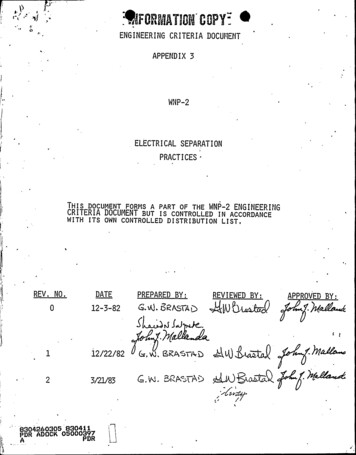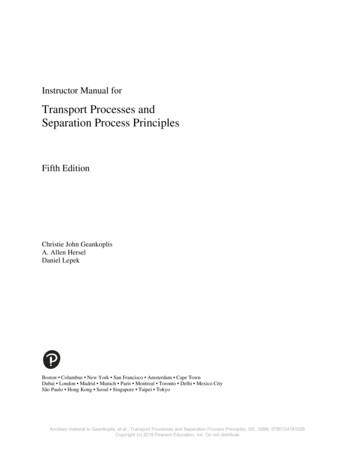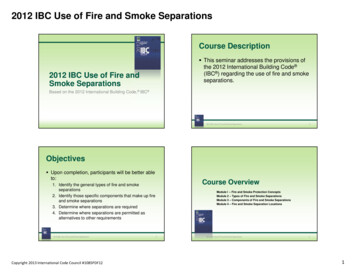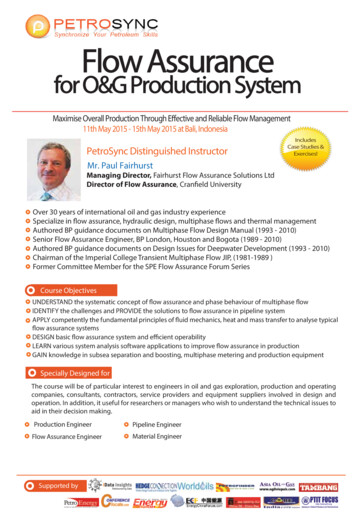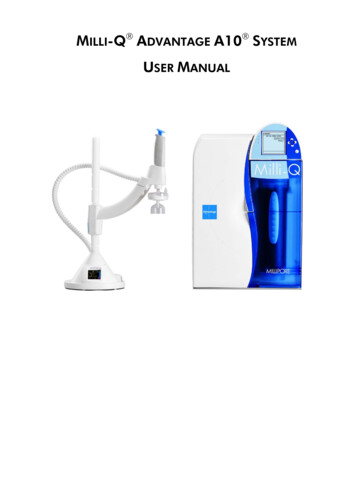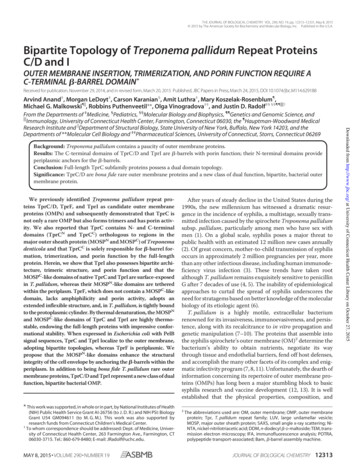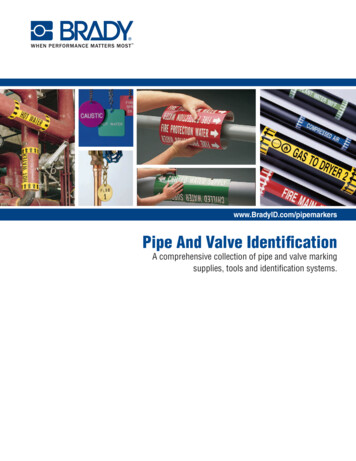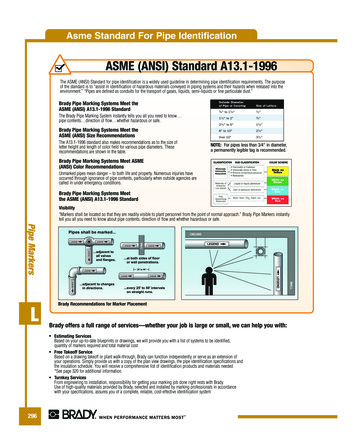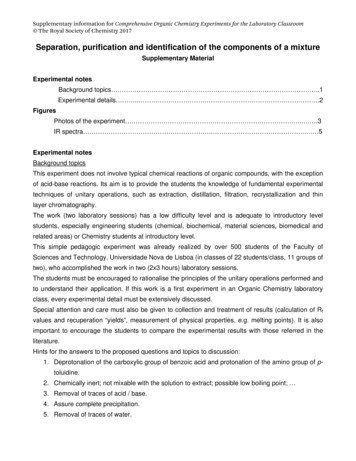
Transcription
Supplementary information for Comprehensive Organic Chemistry Experiments for the Laboratory Classroom The Royal Society of Chemistry 2017Separation, purification and identification of the components of a mixtureSupplementary MaterialExperimental notesBackground topics .1Experimental details . .2FiguresPhotos of the experiment . . .3IR spectra . . 5Experimental notesBackground topicsThis experiment does not involve typical chemical reactions of organic compounds, with the exceptionof acid-base reactions. Its aim is to provide the students the knowledge of fundamental experimentaltechniques of unitary operations, such as extraction, distillation, filtration, recrystallization and thinlayer chromatography.The work (two laboratory sessions) has a low difficulty level and is adequate to introductory levelstudents, especially engineering students (chemical, biochemical, material sciences, biomedical andrelated areas) or Chemistry students at introductory level.This simple pedagogic experiment was already realized by over 500 students of the Faculty ofSciences and Technology, Universidade Nova de Lisboa (in classes of 22 students/class, 11 groups oftwo), who accomplished the work in two (2x3 hours) laboratory sessions.The students must be encouraged to rationalise the principles of the unitary operations performed andto understand their application. If this work is a first experiment in an Organic Chemistry laboratoryclass, every experimental detail must be extensively discussed.Special attention and care must also be given to collection and treatment of results (calculation of Rfvalues and recuperation “yields”, measurement of physical properties, e.g. melting points). It is alsoimportant to encourage the students to compare the experimental results with those referred in theliterature.Hints for the answers to the proposed questions and topics to discussion:1. Deprotonation of the carboxylic group of benzoic acid and protonation of the amino group of ptoluidine.2. Chemically inert; not mixable with the solution to extract; possible low boiling point; 3. Removal of traces of acid / base.4. Assure complete precipitation.5. Removal of traces of water.
Supplementary information for Comprehensive Organic Chemistry Experiments for the Laboratory Classroom The Royal Society of Chemistry 2017Experimental detailsExperimentally the work is simple, with low difficulty and hazard levels.In the “separation” step explain to the students how to recognize and distinguish an organic layer froman aqueous layer and how to separate them correctly. Ask them how to increase the rate of anextraction.In the “recovery” step it is important to assure the complete reversal of the pH of the solutions forcomplete precipitation of the compound to be isolated. Ask the students how to test if this hasoccurred and how to proceed if the result is not satisfactory (use indicator paper and add more acid orbase if necessary). Concerning the naphthalene solution in methylene chloride left after extraction withaqueous solutions, teach the students how to dry a liquid (use of a good drying agent, clearness of theliquid, efficient filtration).The “TLC” part is very important to verify the “success” of the experiment. Show the students how toapply the samples, to prepare the camera, to develop the elution, to reveal the spots. Encourage themto compare the spots from the initial mixture with the spot(s) from each separated compound. Showthem how to calculate correctly the Rf values. Average Rf values (CH2Cl2 / silica gel plates): benzoicacid 0.37; p-toluidine 0.47; naphthalene 0.88.The results of the TLC test show clearly which of the three isolated compound is less pure. Usually itis naphthalene; ask the students the reason (it is the last one remaining after the sequential separationsteps and accumulates all the impurities). Naphthalene is therefore the better candidate to be purifiedby recrystallization. However, it should be interesting to suggest other groups in the laboratoryclassroom to recrystallize also p-toluidine and benzoic acid, and encourage all the students to sharethe results obtained by each group. Recommended solvents for recrystallization are: commercialethanol for naphthalene; distilled water for benzoic acid; petroleum ether (40-60 ) for p-toluidine.For every compound the students must weigh the amount of the compound before (crude) and after(purified) recrystallization. The same applies to the measurement of the melting points. In both cases,the results should be compared and interpreted. Discuss with the students the melting point value as a“criterion” of purity of a compound (comparison with values from the literature).Some experimental results obtained by the students in the laboratory are presented in Table 1.1.1.Table SM 1.1.1. Typical experimental results obtained in the LaboratoryCompoundRecuperation (%)Melting point ( C)p-toluidine40 - 4840 - 43benzoic acid40 - 67110 - 115naphthalene (crude)72 - 8074 - 77naphthalene (recrystallized)40 - 5078 - 79
Supplementary information for Comprehensive Organic Chemistry Experiments for the Laboratory Classroom The Royal Society of Chemistry 2017Finally, an additional characterization can be made by recording the IR spectra of the purifiedcompounds. For this purpose a further 3 hours session may be needed. Students will be familiarizedwith the technique of preparing a solid transparent disc for IR spectroscopy, by using a small amountof a dried sample of the purified compound and KBr as the adequate support material. Theassignment of the absorption bands characteristic of the functional groups of the compounds will bean excellent complement of the work.FiguresPhotos of the experimentFig. SM 1.1.1. Acid/base extractionFig. SM 1.1.2. Recovery of naphthalene
Supplementary information for Comprehensive Organic Chemistry Experiments for the Laboratory Classroom The Royal Society of Chemistry 2017Fig. SM 1.1.3. Aqueous extracts A and B and recoverednaphthaleneFig. SM 1.1.4. Precipitation of p-toluidine andbenzoic acidFig. SM 1.1.5. TLC plates (under UV light)Fig. SM 1.1.6. Recrystallization of naphthaleneLeft: too concentrates samplesRight: correct samples
Supplementary information for Comprehensive Organic Chemistry Experiments for the Laboratory Classroom The Royal Society of Chemistry 2017SpectraFig. SM 1.1.7. IR spectrum of benzoic acid (in KBr disk)Fig. SM 1.1.8. IR spectrum of p-toluidine (in KBr disk)
Supplementary information for Comprehensive Organic Chemistry Experiments for the Laboratory Classroom The Royal Society of Chemistry 2017Fig. SM 1.1.9. IR spectrum of naphthalene (in KBr disk)
Supplementary information for Comprehensive Organic Chemistry Experiments for the Laboratory Classroom The Royal Society of Chemistry 2017Isolation of ( )-Limonene from orange oilSupplementary MaterialThe extraction of ( )-Limonene from orange oil is a popular experiment done in our laboratory withstudents from the first years of the graduation in Chemistry and Chemical Engineering, but also bystudents from other degrees. It is used to exemplify the use of the common techniques of steamdistillation, vacuum fractional distillation and liquid-liquid extraction. It is also useful for introducingthe students on the usual methods to assess the purity of a liquid product by comparing therefraction index, boiling point and specific rotation of the product with the literature values. It is agood example to introduce the study of chirality and optical rotation.The orange oil used in our laboratory classes was a kind gift from SUMOL COMPAL Company(previously SUMOLIS). According to the literature, it can be also extracted from orange peel withan average yield of 0.3%.1 However, when we performed the extraction the yield was so low thatwas unpractical for students. Figure 1 shows a steam distillation apparatus.Figure SM 1.2.1: Steam distillation of orange oil.In the absence of material or conditions to perform the steam distillation, an alternative method(Method B) is suggested where ( )-Limonene can be isolated only by fractional distillation oforange oil. This affords the product with a level of purity very similar to the one obtained fromMethod A. The average yield of both methods is 70-80%. The refraction index obtained is normallyin the range 1.474-1.476, and the specific rotation in the range 111º to 125º.The boiling point of pure Limonene obeys the formula log P - 2296/Teb 8.0163, where Pis the pressure in mmHg and Teb the boiling point in K.2 Note the use of common logarithms (base10). This formula can be used to assess the purity of the product distilled, together with therefraction index (nD20 1.4730) and specific rotation ([a]D20 125.6º) of pure limonene.12O. S. Rothenberger, S. B. Krasnof and R. B. Rollins, J. Chem. Ed. 1980, 57, 741.R. Weast, CRC Handbook of Chemistry and Physics, 1st Student Ed. 1988 Florida.
Supplementary information for Comprehensive Organic Chemistry Experiments for the Laboratory Classroom The Royal Society of Chemistry 2017Isolation of plant pigments from green and red leavesAlice M. Diasa*, Maria La S. FerreiraaaDepartment of Chemistry, University of Minho, Campus de Gualtar 4710-057 Braga, PortugalSupplementary Material1. Introduction . . . . . . 12. Additional notes on the extract preparation . . . . . 23. Additional notes on the column packing . . . . . 44. Additional notes on the column elution . . . 51. IntroductionThe traditional separation of plant pigments from extracts of green leaves (usually spinaches) bycolumn chromatography has been used, during the last twenty years, in the practical classes ofOrganic Chemistry at the University o Minho (Braga). The separation of yellow and green bandsinto silica columns has delighted the 1st year students of Chemistry, Biology, Biochemistry degrees,and also by Biological Engineer students. This experiment is part of a set of activities, usuallyincluding recrystallization, extraction and distillation experiments, designed to introduce theprinciples and practice of purification and separation techniques in Organic Chemistry. At the end ofeach semester, all these students were asked what experiment they enjoyed most. Every year, thechromatography of plant pigments was the most often identified experiment. Aiming to improve theattractiveness and the learning methods provided by this experiment, a novel experiment wasdeveloped replacing the green leaves by green and red leaves (A. M. Dias, M. L. Ferreira, J. Chem.Educ., 2015, 92, 189–192). A more colourful and challenging column resulted incorporating thehydrophilic anthocyanins. An additional red band can be visualized on the top of the column thatcan be successfully eluted by the use of fairly polar organic solvents. Interest in green chemistryprinciples led to the search for safer and inexpensive adsorbents leading to selection of potatostarch as alternative adsorbent to the more hazardous silica stationary phase.1
Supplementary information for Comprehensive Organic Chemistry Experiments for the Laboratory Classroom The Royal Society of Chemistry 20172. Additional Notes on the extract preparationThe most experimentally challenging aspect of the separation of carotenoids, chlorophylls andflavonoids by column chromatography, in a unique and green experiment, is the preparation of asuitable extract from green and red leaves.Diverse red- or purple-leaf plants are suitable sources of both anthocyanins and chlorophylls.Plants with multi-coloured leaves may be used, provided that they have considerable amounts ofred colour. We selected the Stromanthe sanguinea species (Fig. SM 1.3.1a), because their leaveshave a green upper face and the lower face is dark red.Maceration of the well-crushed (Fig. SM 1.3.1b) leaves with acetone gives good results. Acetonehas the intermediate polarity required to extract both hydrophilic and hydrophobic pigments fromgreen and red leaves. Direct application of this crude extract onto the column is not convenient, dueto the presence of acetone mixed with residual water released from the vegetal tissues. Thepresence of these polar solvents in the extract will dramatically increase the polarity of petroleumether, the first solvent of the eluent series, preventing the separation of the nonpolar carotenoidsfrom the more polar chlorophylls. Traditional green leaf extracts are usually obtained by eliminationof water and acetone from the crude extract by liquid-liquid extraction in a water/petroleum ethersystem. In this case, this method is impracticable due to the consequent elimination of thehydrophilic anthocyanins in the aqueous layer. At this stage, students must realize that the pigmentmolecules show distinct physical and chemical properties, like colour, solubility and acid-basecharacter. Even so, they may be challenged to find solutions to remove the water from the extractmaintaining all the pigments together.(a)(b)(c)Figure SM 1.3.1 (a) Stromanthre sanguinea leaves; (b) Crushed leaves; (c) Crude extract under anhydrous sodiumsulphate.2
Supplementary information for Comprehensive Organic Chemistry Experiments for the Laboratory Classroom The Royal Society of Chemistry 2017The elimination of water can be accomplished by treatment of the crude extract with a desiccatingagent, such as kitchen salt or anhydrous sodium sulphate (Fig. SM 1.3.1c). The solid may be easilyremoved from the extract by gravity filtration. It is very important to use sufficient amount ofdesiccating agent, because the column may be clogged if a significant amount of water enters thepacking of the column. Thus, an efficient desiccating is essential. During this period, the studentsmust analyse the extract composition by paper chromatography (Fig. SM 1.3.2).Figure SM 1.3.2 Paper chromatography (petroleum ether 40 - 60 C / acetone 90:10) liquid extract (Fig SM1.3.1c) with the following Rf values: -carotene, Rf 0.87; xanthophyll, Rf 0.87; chlorophyll a, Rf 0.87; chlorophyll b, Rf 0.87; anthocyanins,Rf 1.0.The pigments can be identified on the basis of characteristic colours and relative affinities to mobileand stationary phases. The results can be interpreted and discussed relating molecular structureswith polarity, intermolecular bonds, adsorption and solubility concepts. Principles of green chemistryshould be also introduced at this time.At this stage, the students must understand the principles of chromatography and should bestimulated to envisage the elution process into the column chromatography, using the concept ofan eluotropic series. They should realize that the use of nonpolar eluents is required to obtainelution of the nonpolar beta-carotene and, eventually, the slightly more polar xanthophylls. This willhelp to understand the need to remove the acetone from the crude extract. Students may beencouraged to propose alternative solvents to transfer the mixture of the three classes of pigmentsonto the column. The concept of solid solvent must be introduced/remembered. Since cellulose3
Supplementary information for Comprehensive Organic Chemistry Experiments for the Laboratory Classroom The Royal Society of Chemistry 2017afforded a good separation of pigments (paper chromatography), the use of the closely relatedstarches is a good alternative as they are good adsorbents from our daily life and agree withprinciples of green chemistry. The use of the alternative corn starch is not recommended in thisexperiment, it led the column packing to clog.After this discussion period, students can be instructed to prepare the solid extract by adsorption ofthe liquid extract on the surface of potato starch (Fig. SM 1.3.3).Figure SM 1.3.3 Solid extract obtained by adsorption of the liquid extract (Fig SM 1.3.1c) on the surface of potatostarch.They will observe a fast evaporation of the acetone by stirring the liquid with the finely divided solid.After 10 min the mixture is free of acetone leading to recognize that further procedures to evaporateacetone are not be necessary. The effect of the surface area on the rate of evaporation should bementioned, making clear that this procedure avoids less sustainable heating or vacuum processesand prevents pigment degradation. Moreover, the hydration capacity of starches may be useful inretain traces of moisture on the surface of starch.3. Additional notes on the column packingDisposable syringes of 10 mL or 20 mL are selected to support the packing of the column, becausethey are inexpensive items that may be freely reused avoiding the risks associated with glassmaterials. The use of thinner columns is not advisable, because the percolation rate through thecolumn is too slow due to the small particle size of starch granules. The column packing is the mostvariable factor of this experiment and may cause, sometimes, lack in the reproducibility. The use of4
Supplementary information for Comprehensive Organic Chemistry Experiments for the Laboratory Classroom The Royal Society of Chemistry 201720 mL syringe gives more reproducible results. The use of a slurry, made up with potato starch andpetroleum ether, also gives more reproducible results, when compared with the dry method. Thiscolumn experiment was repeated a few dozen times and it can be stated that the reproducibility ofthis column should not be inferior, when compared with the silica packing of columns. It should alsobe noted that the normal use of a layer of sand at the top of the column is not recommended, sincethis would mask the visual effect of the pinkish band due to the anthocyanins on the top of thecolumn. The top of the packing of this column is particularly fragile and the eluents must be addedcarefully to the column to avoid irregular bands.After loading the column with petroleum ether, an appropriated amount of the solid extract iscarefully applied on the top of the packing (Fig. SM 1.3.4). No more than the recommendedamount of solid extract should be used.Figure SM 1.3.4 Potato starch column chromatography immediately before elution (0 min).4. Additional notes on the column elutionThe results of the elution are strongly related to the packing process and the eventual presence oftraces of acetone and/or water in the extract. Typically, the elution of the column with petroleumether 40-60 ºC led to the development of a colourful column within 5-10 min, showing two wellseparated yellow bands, two fairly-well defined green bands and one pink band on the top of thecolumn (Fig. 5). The first yellow band was easily isolated with petroleum ether and was composed5
Supplementary information for Comprehensive Organic Chemistry Experiments for the Laboratory Classroom The Royal Society of Chemistry 2017only by carotenes. The second yellow band, detected quite high up in the column, is retained duringelution with this solvent. Elution with a mixture of petroleum ether/acetone 90:10 afforded a newcolour pattern in the column, showing one yellow band at the bottom of the column that is followedby two green bands, one bluish green band and one yellowish green band, with the pink bandretained on the top of the column (Fig. SM 1.3.6). Based on their characteristic colours and polarity,these bands could be easily assigned to xanthophylls, chlorophylls a and b, and anthocyanins,respectively. Thus, in an elution period of 30-45 min, an attractive column could be achievedrevealing the major components of the extract obtained from green and red leaves. It should bementioned that different plant species might lead to different results. However, differences in thecontent of pigments may be easily predicted by early paper chromatography analysis of the extract.Sometimes, the beta-carotene is too faint to be identified on the column. In this case, elution bypetroleum ether should be maintained for 10 min, before changing to the next eluent.The elution of xanthophylls and chlorophylls from the column takes about 30 min more (Fig. SM1.3.7 and 1.3.8). By elution with a petroleum ether/acetone mixture 90:10 two fractions werecollected and evaluated by paper chromatography: the first one showed an intense yellow colourand was mostly composed of xanthophylls, but was slightly contaminated with chlorophyll a; thesecond fraction, with a bluish green colour, was composed only by chlorophyll a. Petroleumether/acetone mixture 75:25 afforded a yellowish green fraction with a unique spot ofchlorophyll b. Acetone can be used to elute the flavonoids from the column, which take further 20min. An acetone wash of the column gave one last crop that blushed red by addition of aciddemonstrating the presence of anthocyanins.We can state that these simple, accessible and safe experimental conditions provide an attractiveand efficient separation of pigments from red and green leaves. A colourful column is obtained withyellow, blue-green, yellow-green and red bands. The composition the corresponding extracts (Fig.SM 1.3.9) was evaluated by paper chromatography demonstrating an efficient separation of betacarotene, xanthophylls, chlorophyll a and b, and anthocyanins (Fig. SM 1.3.10).6
Supplementary information for Comprehensive Organic Chemistry Experiments for the Laboratory Classroom The Royal Society of Chemistry 2017Figure SM 1.3.5 Potato starch column chromatography by elution with petroleum ether 40‐60 C (5 min).Figure SM 1.3.6 Potato starch column chromatography by elution with the mixture of petroleum ether 40 60 C / acetone 90:10 (23 min).7
Supplementary information for Comprehensive Organic Chemistry Experiments for the Laboratory Classroom The Royal Society of Chemistry 2017Figure SM 1.3.7 Potato starch column chromatography by elution with the mixture of petroleum ether 40 60 C / acetone 90:10 (28 min).Figure SM 1.3.8 Potato starch column chromatography by elution with the mixture of petroleum ether 40 60 C / acetone 90:10 (32 min).8
Supplementary information for Comprehensive Organic Chemistry Experiments for the Laboratory Classroom The Royal Society of Chemistry 2017Figure SM 1.3.9 Main fractions eluted from potato starch column chromatography.Figure SM 1.3.10 Paper chromatography (petroleum ether 40 - 60 C / acetone 90:10) of the main elutedfractions (same order as in Fig. 9).9
Supplementary information for Comprehensive Organic Chemistry Experiments for the Laboratory Classroom The Royal Society of Chemistry 2017Extraction of Usnic Acid from LichenSupplementary MaterialsStudents in our teaching laboratories use a PolyScience SR-6 Polarimeter to carry outtheir measurements. However, the instructions in this experiment have been writtenmore generally so that other polarimeter models can be readily employed by just addingfurther directions on instrument operation. Each set of measurements (unknown andthen the usnic acid) takes 5-10 minutes each. Most of the learner’s laboratory time isspent on the bench work extracting, isolating and recrystallizing the usnic acid. It isrecommended that at the recrystallization stage that students proceed to measuring themelting point and optical rotation of their unknown compound (L-tartaric acid). Table SM1.4.1 gives a sense of the range of results students obtain in this experiment.OCH3OH3COOHOOH*OCH3HOOH3CH3CS usnic acidH3COH*CH3H3CHOOHOOOCH3OHOOHHOOH**H3COHCH3R usnic acidOH3COCH3OOCH3H3COOHOCH3* denotes chiral centreFigure SM 1.4.1 – R and S Usnic Acid Showing Two Views of Each Enantiomer1
Supplementary information for Comprehensive Organic Chemistry Experiments for the Laboratory Classroom The Royal Society of Chemistry 2017Table SM 1.4.1 – Sample Usnic Acid Yields and Polarimetry Results1st Crop (g)2nd Crop (g)mp (º C) Yielda(% Wt Lichen)0.5160 204-205 4934.300.20280.2545202-203 4583.800.3971 195-196 4693.310.3840 198-199 482.63.200.3766 191-192 5003.140.3626 200-202 3703.020.3480 203-204 4872.900.3380 191-192 428.32.820.5491 195-196 457.22.770.3264 193-194 484.42.720.3180 199-200 4662.650.3082 195-196 4822.570.3067 195-196 4812.560.2477 200-202 4732.060.2436 205-206 453.12.300.2160 202-204 4731.800.0186201-202 469.81.570.1339 197-199 444.11.110.1080 204-206 4400.900.0541 195-197 3520.45b0.0559cca) Percent pure usnic acid by weight from total biomass of the lichen. b) Approximately 20 glichen used. c) 4.75 g lichen used.2
Supplementary information for Comprehensive Organic Chemistry Experiments for the Laboratory Classroom The Royal Society of Chemistry 2017Table SM 1.4.2 – Pertinent Physical ValuesSamplemp (º C)Sample Concentration(g/mL)Water (blank)0neat 0.01L-( )-Tartaric acid(unknown)171-1740.16-0.20 12.7THF (blank) 108.5neat 0.01R-( )-Usnic acid 3201-203 ( ) 464a 4 10a) Student average. Literature values α(c 0.7, CHCl3)2 466 (c 0.02, THF)1 and α 469 Sample Calculations:YieldRecovered 0.4789 g of pure usnic acid from 12.123 g lichen% yield by weight0.4789 g12.123 g1001003.95 %Observed RotationPolarimeter reading of neat distilled water was 0.02 and the aqueous unknown samplewas 2.47.αα solutionα blank2.47 –0.0232.45
Supplementary information for Comprehensive Organic Chemistry Experiments for the Laboratory Classroom The Royal Society of Chemistry 2017Specific RotationThe observed rotation is 3.79º for a 0.00402 g mL 1 solution in a polarimeteremploying a sample cell that is 200 mm long.202 dm3.79 0.00402 g/mL471 [Formally the units for specific rotation are deg mL g 1 dm 1, but it is normally reported just inunits of degrees.]1D. W. Mayo, R. M. Pike, and D. C. Forbes, Microscale Organic Laboratory: With Multistep andMultiscale Syntheses, John Wiley & Sons, Toronto, 5th ed., 2010, Instructor’s Notes for MOL, Chapter 6,13.2CRC Handbook of Chemistry and Physics, ed. R. C. Weast, CRC Press, Boca Raton, 67th ed., 1986,C-541.4
Supplementary information for Comprehensive Organic Chemistry Experiments for the Laboratory Classroom The Royal Society of Chemistry 2017Thin layer chromatography of plants pigmentsSupplementary MaterialpageExperiment notes1FiguresPhotos of the experiment2TLC interpretation5Experiment notesThe main goal of this experiment is the extraction, separation and identification of themajor pigments of spinaches. This experiment is much appreciated by studentsbecause they easily recognized the raw materials and the pigments involved. Theexperimental work was projected to be developed in one three hour session and canbe carried out with several vegetable samples (fresh, frozen or canned spinaches,carrots, kale etc.). Depending on the vegetable sample (fresh or frozen), conditions ofthe experiment and amount of sample spotted on the TLC plate, the TLC pattern canchange. It is very common to observe other pigments on samples of frozen spinachesresulting from air oxidation, hydrolysis and other chemical reactions as mentioned inthe “Background”.In spite of being a quite simple experiment and easy to perform, several precautionsmust be taken to have good pigments extraction yields.-If frozen samples are used, the vegetable must be squeezed to eliminate asmuch freezing water as possible.-If necessary, a small amount of sea sand can be added to the mortar to helpthe grinding and extraction process.1
Suppllementary infoormation for ComprehensiveCe Organic Chemmistry Experimeents for the Labboratory Classroom Thee Royal Societyy of Chemistryy 2017-During the grindingg of the spinnaches withh acetone, usually a majormquanttity ofsolvent willw evaporaate. At the end of steep 4 (Experrimental proocedure) ussuallymore aceetone is neeed to be addded to commpensate thee evaporation.-The aceetone extracct withdrawwal may cauuse some problems. A pipette withwasmall pieece of cotton swirled att the end (see Fig SM 1.5.3) mighht be useful.-Since noo dry agentt is added duringdthe grinding process, after the addition ofthe n-heexane and shaking, a lower wateer phase cancbe formmed and a threephase systemscann appear. This phenoomenon dooes not intterfere withh theexperimeent successs.-For TLC, use flexiblle precoatedd silica gel F254 plates with fluoresscent indicaator. Ifthe platees have nott been purcchased receently, place them in ann oven at 1000 ºCfor 30 min.This experiment has beenn assayed byb four grouups of two studentssfromm the 2nd yeear ofthe Integratedd Masters DegreeDin PharmaceuPutical Sciences (Facultty of Pharmmacy,Uniiversity of Lisbon).LAll groups werre able to reeach the ennd of the exxperiment withw averyy nice and well developed TLC plate, simillar to the oneopresentted in figuree SM1.5.7.Photos of thee experimeent2
Suppllementary infoormation for ComprehensiveCe Organic Chemmistry Experimeents for the Labboratory Classroom Thee Royal Societyy of Chemistryy 2017Figg. SM 1.5.1. Material aand reagentts.Fig. SM 11.5.2. Outloook of the soolid-liquid exxtraction.Fig.SM 1.55.3. Pipette adapted for acetone withdrawal.wFig.SM 1.5.4. Outlook of the liquuid-liquid exxtraction.3
Suppllementary infoormation for ComprehensiveCe Organic Chemmistry Experimeents for the Labboratory Classroom Thee Royal Societyy of Chemistryy 2017acbSM 1.5.5. Different stagges of TLC experimentt: (a) sampling; (b) at thhe beginninng;Fig.S(c) affter a few minutes;mabFig. SM 1.5.6. TLC outloook. (a) frozeen leaves; (bb) fresh leavves.4
Suppllementary infoormation for ComprehensiveCe Organic Chemmistry Experimeents for the Labboratory Classroom Thee Royal Societyy of Chemistryy 2017C interpreetationTLCIn thee spinach leeaves crudee extract thee following pigments caan be preseent:β-Caarotene1 spot; yellow orange; RffPheoophytin a1 spot; grayPheoophytin b1 spot; gray ( mayy be absent)Chlorophyll a1 spot; light-greennChlorophyll b1 spot; greenXantthophylls3 possible spots; yellow; RfFig. SSM 1.5.7. TLCTof frozeen (a) and
techniques of unitary operations, such as extraction, distillation, filtration, recrystallization and thin layer chromatography. . If this work is a first experiment in an Organic Chemistry laboratory class,

